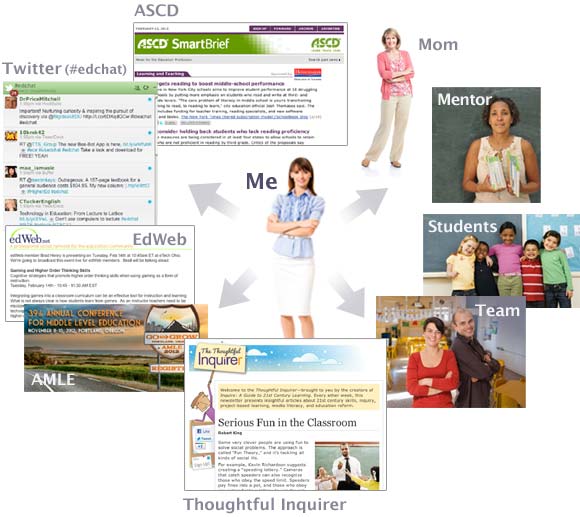What does your PLN look like?
You may have heard colleagues talk about their PLNs—their personal learning networks—or you may have one of your own. But just what is a personal learning network, and why is it so helpful for educators?
What is a PLN?
A personal learning network consists of the people, places, and things that help you learn. By definition, every lifelong learner has a PLN, whether the person realizes it or not. Also, every person who has a PLN is a lifelong learner. Let’s imagine, for example, that you are a relatively new teacher. Your PLN might look like the following:

Why is a PLN important?
Having an active personal learning network is important for a number of reasons:
- Lifelong learning: A PLN helps you learn and grow. Your professional and personal development is important for you and your students. If you are an active, lifelong learner, you’ll naturally model that process for your students.
- Community: All learning is social. When we learn something new, we want to share it with others. Having a PLN connects you with others, helping you share discoveries, triumphs, and troubles.
- PD shift: Professional development has been shifting for some time now, from daylong sessions with speakers and room filled with teachers to a more individualized approach. A PLN helps you get a little professional development every day rather than all in one marathon session.
- Conversation: Having a PLN puts you in the center of the educational conversation, letting you shape new trends and reform efforts.
How can I develop a PLN?
Start with what you have. Draw a cluster, putting yourself at the center and writing down all the people, places, and things that help you learn. Think about the following possibilities:
- Colleagues at your school or from previous experiences
- Students, from whom you learn every day
- Friends and family members
- Professional organizations such as the Association of Middle Level Educators, the National Council of Teachers of English, and the National Council of Teachers of Mathematics
- Newsletters such as The Thoughtful Inquirer
- Social media such as Twitter (using hashtags such as #edchat, #scichat, #sschat), Edweb, LinkedIn, and Nings (Check out Jim Burke’s English Companion.)
- Programs such as NOVA or Mythbusters (science teachers), historical documentaries (history teachers), or Masterpiece Theater (ELA teachers)
- Books such as Inquire: A Guide to 21st Century Learning
- Conferences and other professional-development opportunities
- Museums, fairs, reenactments, and other educational experiences
Then look for gaps. Do you wish you had a teacher mentor who could help you with classroom management? Do you wish you had a former professor who could keep you abreast of the latest developments in education? Do you wish you could explore the Abraham Lincoln Presidential Library and Museum in Springfield, Illinois, or the National Air and Space Museum in Washington, DC? Whatever you wish, go out and make it happen. Find a connection. Make a friend. Start a correspondence.
Invite others along. Your PLN will overlap the personal learning networks of others. The more people you connect with, the richer everyone becomes.
We want to hear from you! Who are the most valuable people in your personal learning network? What organizations and resources do you rely upon? Please leave comments below.


Comments
PLN's
You have made it so much clearer for me as a new and up-coming teacher. I have been trying to give my e-Portfolio a new a better look!
Now everything seems so organized!
You need one!
I've had a PLN for years and am always surprised to find how many people don't take time to cultivate one. Twitter is a key component in my PLN, and one of the ways I stay ahead of the curve.
Post new comment